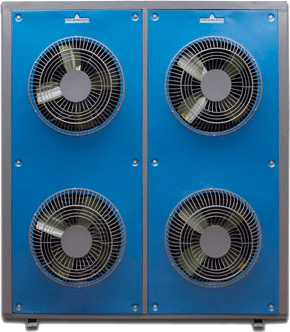Copper heat ex-changers have copper tubing expanded into copper cooling fins for excellent heat transfer. Flux less, silver-brazed joints provide leak-free reliability and 0.028″ (0.7mm) seamless wall tubing ensures fluid circuit durability. The recommended coolant for a copper heat ex-changer is water or ethylene glycol with water. The Scanair SAHC Series copper and oil heat ex-changers are electro-static dip painted for hostile environments and all units are supplied with built-in, fan-ready mounting hardware.
The Scanair SAHS Series Oil heat ex-changer is our highest performing stainless steel tube heat ex-changer. It is ideal for applications where deionizer water or corrosive fluids are used, and a high efficiency, compact unit is required. The heat ex changer has a superior construction with 316L stainless steel tubing expanded into copper cooling fins. The all-welded, argon-purged joints of the heat exchanger maximize its internal cleanliness, the pre cleaned internal surface eliminates fluid contamination, and the 0.028″ (0.7 mm) wall tubing ensures fluid circuit durability. The Scanair Series heat exchangers are available in straight, beaded, or 37° AN flare fittings.

Scanair brazed-plate heat ex-changers are designed for liquid-to-liquid heat transfer. Their innovative design packs maximum performance into a compact and reliable package. The herringbone construction allows for maximum heat transfer making this heat exchanger extremely efficient. The liquid-to-liquid brazed plate heat ex-changer is a highly reliable and rugged part with stainless steel sheets brazed together at the edges and at a matrix of contact points. Compatible with a wide range of fluids, we offer copper brazed for water, EGW and other common coolants. Our nickel-brazed units are appropriate for use with deionizer water, high purity, and corrosive fluids. High operating temperatures and pressures: Copper-brazed units can be operated at temperatures of up to 383°F (195°C) and pressures up to 450 psig (31 bar). Nickel-brazed units can be operated at temperatures of up to 662°F (350°C) and pressures up to 232 psig (16 bar).
Liquid-to-liquid heat ex-changers are up to 80-90% smaller in volume and weight than a conventional shell-and-tube design. The counter flow design utilizes stainless steel sheets stamped with a herringbone pattern of grooves, stacked in alternating directions to form separate flow channels for the two liquid streams. This allows 90% of the material to be used for heat transfer, making it extremely efficient. The plates are brazed together at the edges and at a matrix of contact points between sheets, ensuring that the heat ex-changers are highly reliable and rugged.
Scanair cold plate can be custom designed and manufactured to meet the most demanding thermal and mechanical requirements. Our cold plate experience is extensive. Scanair cold plate technologies include Aluminum vacuum brazed cold plates, copper cold plates, and Liquid cooled chassis which consist of multiple cold plates. Large cold plates for medical and industrial applications, and everything in between. Every custom cold plate is different, but the design process is the same. Our project engineers use advanced thermal analysis software to model your heat loads and arrive at a cold plate design that meets your thermal and pressure drop performance requirements. Our manufacturing engineers ensure that the cold plate is cost-effective to build and is designed for high reliability. A component such as fittings, manifolds, hoses, and quick disconnects. We can even incorporate sensors, controllers, and other accessories into the cold plate design. These may be customer supplied or we can source them. Either way, your cold plate arrives ready to drop into your system, saving you time and energy.
The drive towards higher powers and more compact packages is making liquid cooling a necessity in many applications. Hydraulic power pack, Centrifugal blower bearing cooling, this presents many challenges, particularly to those new to liquid cooling. We manufacture all the thermal components in a cooling loop, so we view the cold plate as part of a larger system rather than in isolation. This in-depth understanding results in more cost-effective and innovative solutions to your thermal challenges.


